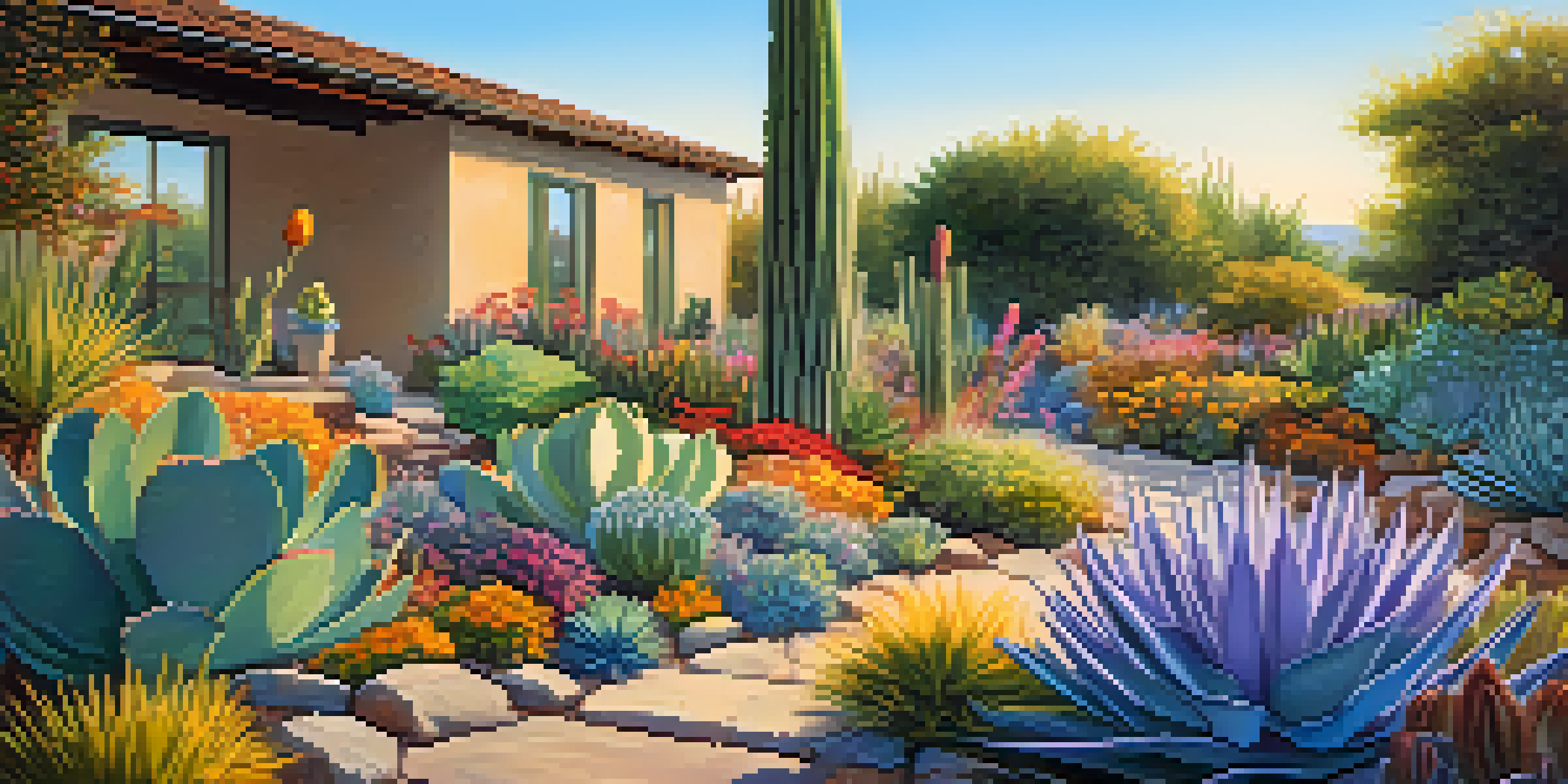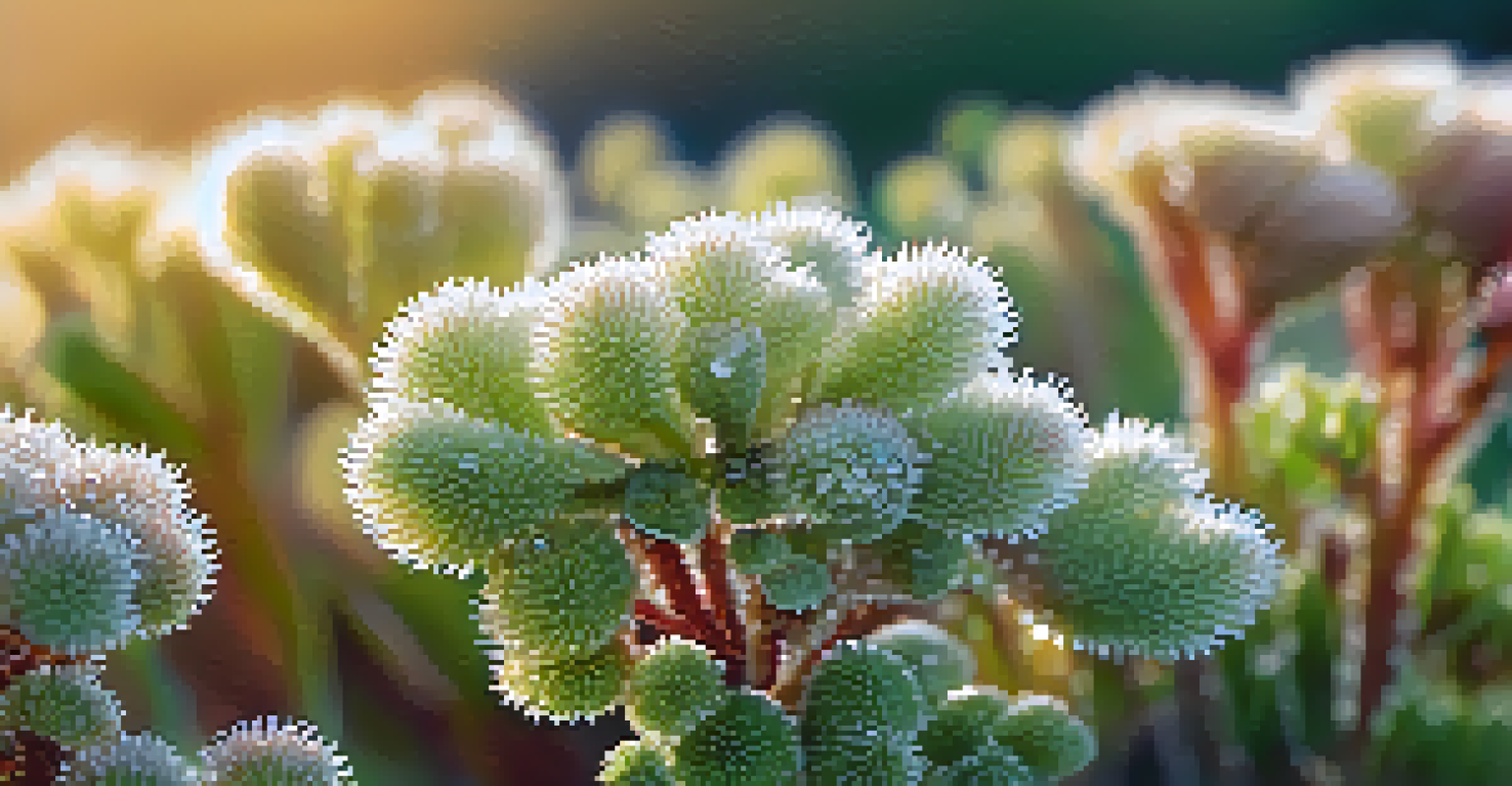How to Select Drought-Resistant Plants for Your Landscape

Understanding Drought-Resistant Plants and Their Benefits
Drought-resistant plants are species that can thrive with minimal water, making them ideal for arid climates or water-scarce areas. By choosing these plants, you're not only conserving water but also creating a sustainable landscape that supports local ecosystems. These plants often have adaptations such as deep root systems or waxy leaves that help them retain moisture.
The true meaning of life is to plant trees, under whose shade you do not expect to sit.
Incorporating drought-resistant plants can lead to a vibrant garden that requires less maintenance and fewer resources. Imagine cultivating a garden that flourishes during dry spells, reducing the stress of watering and the worry of plant loss. This not only enhances your outdoor space but also contributes to environmental health.
Ultimately, selecting drought-resistant plants is a positive step towards a more sustainable lifestyle. It allows you to enjoy beautiful, resilient landscapes while promoting water conservation and biodiversity. As we face increasing climate challenges, these plants are becoming essential allies for gardeners everywhere.
Assessing Your Landscape's Conditions and Needs
Before selecting plants, take a good look at your landscape's specific conditions. Factors like soil type, sunlight exposure, and drainage can significantly impact plant growth. Understanding these elements will help you make informed choices about which drought-resistant plants will thrive in your space.

Consider conducting a simple soil test to determine its composition and moisture retention capabilities. If your soil tends to drain quickly, you might want to opt for plants that are particularly tolerant of dry conditions. On the other hand, if your soil retains moisture but experiences dry spells, look for plants that can handle both extremes.
Choose Drought-Resistant Plants
Selecting drought-resistant plants helps conserve water while creating a sustainable landscape.
Additionally, think about how much sun your garden receives throughout the day. Some drought-resistant plants prefer full sun, while others thrive in partial shade. By assessing these conditions, you’ll set the stage for a successful landscape that requires less water and maintenance.
Researching Drought-Resistant Plant Varieties
There are countless drought-resistant plants to choose from, so it’s essential to do your research. Start by familiarizing yourself with native plants in your region, as they are typically well-adapted to local climate conditions. For instance, succulents and various grasses are often excellent choices for arid environments.
In every walk with nature one receives far more than he seeks.
Look into perennial plants that can withstand dry conditions and return each year, providing lasting beauty with minimal effort. Plants like lavender, sedum, and coneflowers can bring vibrant colors and textures to your landscape without requiring much water. Combining different plants can also create a visually appealing garden.
Don’t forget to consider annual flowering plants that can handle drought once established. These can add seasonal color and interest to your garden while still being water-efficient. By exploring various options, you'll find the perfect mix of plants for your unique landscape.
Designing a Drought-Resistant Landscape Layout
Once you've selected your plants, it's time to think about the layout of your landscape. Grouping plants with similar water needs together can help maximize efficiency and reduce water waste. This technique, known as hydrozoning, ensures that water is used effectively and that plants thrive in their preferred conditions.
Consider using a layered approach to add depth and visual interest to your garden. Taller plants can be placed towards the back or center, with shorter varieties in the front. This not only creates an attractive design but also ensures that all plants receive adequate sunlight.
Assess Your Landscape Conditions
Understanding your landscape's soil, sunlight, and drainage will guide you in choosing the right plants.
Incorporate hardscaping elements like gravel paths or stone borders to reduce water evaporation and create defined spaces. This can also help with drainage and improve the overall aesthetics of your garden. Thoughtful design can enhance the beauty of your drought-resistant landscape while promoting sustainability.
Watering Techniques for Drought-Resistant Plants
Even drought-resistant plants need some water, especially when they are first established. Deep watering techniques, where you provide water less frequently but in larger quantities, can encourage stronger root development. This method helps plants become more resilient to dry conditions over time.
Consider using drip irrigation systems or soaker hoses, which deliver water directly to the roots and minimize evaporation. These systems can save water and ensure your plants receive the moisture they need without over-watering. Setting up a rain barrel can also capture rainwater for irrigation, making your garden even more eco-friendly.
Monitoring weather conditions can help you adjust your watering schedule accordingly. During cooler or rainy periods, you may find that your plants need less water, allowing you to conserve resources. By employing smart watering techniques, you'll support your drought-resistant plants while maintaining a healthy landscape.
Incorporating Mulch for Moisture Retention
Mulch is a fantastic ally when it comes to maintaining moisture in your garden. By applying a layer of organic mulch, such as wood chips, straw, or bark, you can help retain soil moisture and reduce evaporation. This simple addition not only supports your drought-resistant plants but also improves soil health over time.
In addition to moisture retention, mulch can suppress weeds, which compete for water and nutrients. By reducing weed growth, your plants can thrive with less competition, allowing them to make better use of the available resources. Plus, as the mulch breaks down, it enriches the soil with organic matter.
Implement Smart Watering Techniques
Utilizing deep watering and efficient irrigation systems ensures your drought-resistant plants thrive with minimal water.
Remember to refresh your mulch layer regularly, especially during dry spells. This ensures that your plants receive continued benefits and helps maintain a tidy appearance in your garden. With mulch in place, you're setting the stage for a thriving, drought-resistant landscape.
Maintaining Your Drought-Resistant Landscape
Maintaining a drought-resistant landscape doesn't mean letting everything go wild. Regular upkeep is still essential to ensure your plants remain healthy and vibrant. This includes tasks like pruning, deadheading, and checking for pests to keep your garden looking its best.
As your plants establish themselves, observe their growth patterns and adjust your maintenance practices accordingly. Some plants may require more attention initially but will need less care as they mature. Staying attuned to your garden's needs will help you make informed decisions about when to water or prune.

Lastly, consider seasonal changes and how they impact your landscape. Drought-resistant plants may still require some extra care during extreme weather conditions, so be prepared to adapt your routine. By staying proactive, you can enjoy a beautiful, low-maintenance garden that thrives even in challenging conditions.